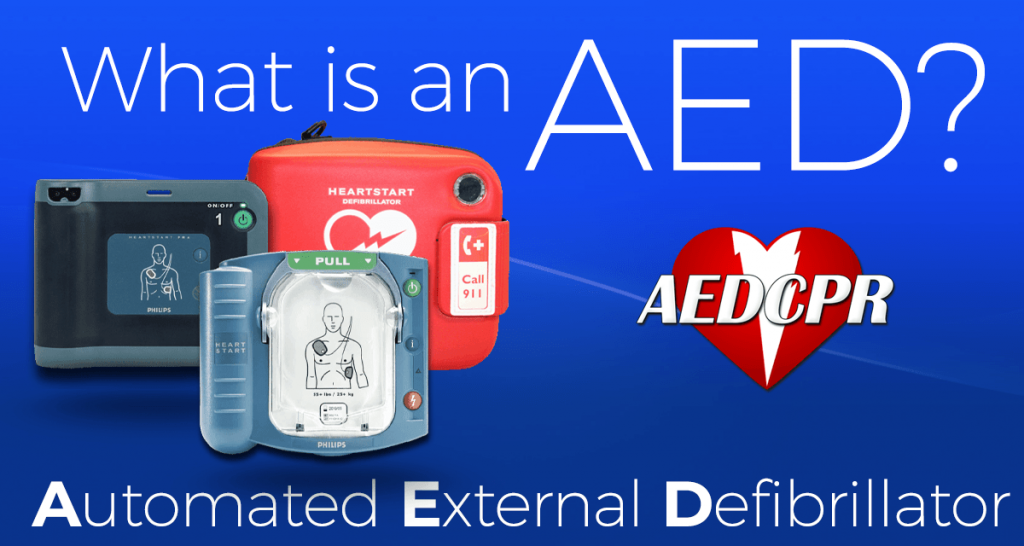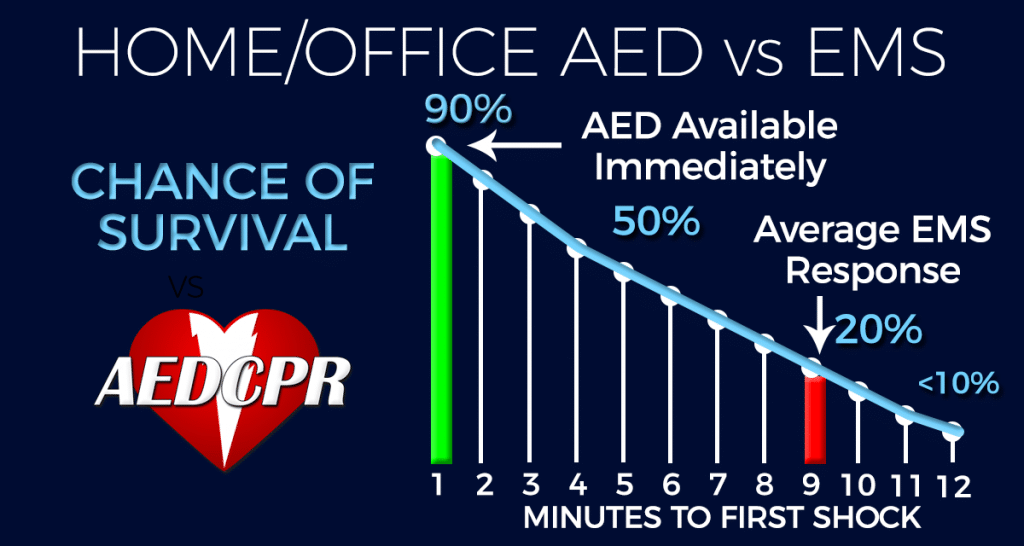
AED Stands for Automated External Defibrillator
An AED is a portable device that is used to diagnose and treat ventricular fibrillation (VF) and pulseless ventricular tachycardia (VT). The AED works by sending a shock through the victim’s chest to stop these life-threatening cardiac arrhythmias. This allows the heart to re-establish a sustainable pulse. AED’s are designed for both the general public as well as trained first responders.
AED Availability Saves Lives
Immediate CPR and defibrillation within 3-5 minutes give the victim the best chance of survival. The chances of survival decrease by nearly 50% if a victim in cardiac arrest is not defibrillated within 5 minutes. The chances of survival decrease another 7% each additional minute without defibrillation. Schools, public buildings, restaurants, stores, parks, private homes, and many other locations now have AED’s available. So when seconds matter, having an AED readily available is the fastest way to provide life-saving treatment.
The goal of public access defibrillation programs is to be no more than 90 seconds away from an AED in public places such as schools, malls, and sports stadiums. In locations equipped with an AED, the survival rate of sudden cardiac arrest has increased substantially. The number of victims defibrillated within 3-5 minutes increases by having an AED available.
Having an AED in your home allows you to provide life-saving treatment of ventricular fibrillation and ventricular tachycardia much sooner than waiting for EMS to arrive. In an emergency situation acting fast is essential, every second matters. If someone is suffering from VF or VT, the ability to provide defibrillation quickly will increase chances of survival by an average of 500% vs waiting for EMS to arrive.
EMS Response Times
The National average EMS response time is well beyond 5 minutes. There are many factors that affect response time. Distance from your fire/EMS station will certainly affect how long it takes for them to arrive. Also, if your local EMS is volunteer, it may take several additional minutes for rescuers to arrive at the EMS station. In addition, other factors like traffic, time of day and weather may affect EMS response times. Many municipalities have a goal of 10 to 12 minutes. The time it takes to call 911, explain the situation and give your location also adds to the amount of time between the cardiac event and defibrillation by EMS.

Deciding If an AED Is Right for Your Home
I generally ask 2 questions. Do you live with someone you care about? Or, do you live with someone who can assist you? Most people answer yes to at least one of those questions. Having an AED is like having insurance. Hopefully you never need it, but if you wait until you do, it will be too late. Waiting for EMS can reduce the chance of survival from 90% to below 10%. Having an AED available can make the difference between life and death.
There is no reason not to have one in every home or office. Especially f someone in your household or office is at risk of a heart attack. You can now purchase an AED to use in your home without a prescription. It is easier than ever to buy an AED.
When Is an AED Needed?
When someone is suffering from Ventricular Fibrillation or Ventricular Tachycardia an AED can help save their life. The AED will diagnose and determine if a shockable rhythm is present. You do not need to know how to read an ECG or diagnose the victim.
Use the AED whenever a victim is unresponsive and has no signs of circulation. The AED will determine if VF or VT is present. If no shockable rhythm is present, the AED will monitor the victim to see if VF or VT
The AED will not shock anyone by accident. You cannot hurt someone by attaching the AED if they have a pulse.
Why Learn to Use an AED?
Thanks to Public Access Defibrillation programs, AEDs are readily available. You will find these life-saving devices in airports, schools, most public buildings as well as many restaurants and stores. By learning how to use one, you can help save a life.
If you have an AED in your home or office, everyone in the household or office should learn how to use it. You can also re-take the course as often as necessary so you feel confident in your skills.
Learning CPR and how to use an AED is always recommended if you live with someone who is at risk. In addition, you can take a CPR/AED and First Aid combination class.
Learning to use an AED is simple. Even if someone else is performing CPR and using the AED, by knowing what to do, you still may be able to help save a life. Get certified today!
Understanding Ventricular Fibrillation
Normal Heartbeat
The heart is a muscle in the center of the chest. It contains 4 chambers. They are the left atrium, right atrium, left ventricle, and right ventricle. The two atria are on the top of the heart, the two ventricles are on the bottom. Like all muscles, the heart contracts by electrical stimulation. The SA Node, located on the top of the heart, is responsible for creating the electrical stimulation that contracts the heart. For the heart to pump blood, it must contract in sequence from top to bottom. The SA node initiates electrical stimulation and sends it down pathways that cause the heart to contract smoothly and in a coordinated sequence. Every heartbeat starts at the SA
Fibrillation
When the electrical stimulation becomes disorganized, the heart will contract in a random manner. Electrical impulses do not follow normal pathways. Fibrils within the heart contract independently. The heart has uncontrollable irregular and chaotic contractions. When the ventricles are fibrillating, the heart is unable to pump blood. The fibrillation and disorganized electrical activity is strong at first. However, it will lose strength quickly. All heart activity will eventually cease.
Causes of VF
- Heart attacks
- Angina
- Electrocution
- Direct cardiac injury
- Heart disease (weakened, enlarged or thickened)
- Extremely high or low potassium levels
- Medications
- Chest trauma
- Defibrillation
A defibrillator uses an electric shock to stop the victim’s heart from fibrillating. A common misconception is that a shock will jumpstart the heart. The defibrillator works by stopping all of the disorganized electrical activity. Therefore, stopping the fibrillation. The SA Node can now send it’s electrical impulse down the normal pathways to initiate normal contractions. The heart can start beating again on its own.
Defibrillation is the most successful when ventricular fibrillation first starts and the heart is full of energy. As the heart loses energy, it also loses the ability to beat on its own. The SA Node will not have the energy to stimulate the heart. And the heart will not have the energy to contract if stimulated. As a result, the chances of survival decline rapidly.
FAQ
AED is to be used by?
Anyone can use an AED. They are very simple to use. It is highly recommended that everyone take a CPR course that includes AED training. However, studies have shown that people with absolutely no training can successfully use modern
What does AED stand for?
AED stands for Automated External Defibrillator
Function of AED?
The function of an AED is to stop the life-threatening cardiac arrhythmias of VF and VT. Early defibrillators were large and bulky, designed for hospital use. As technology advanced, they were also placed in ambulances to help victims before arriving at the hospital. The AED puts the same life-saving treatment in the hands of the lay-rescuer…
What does AED stand for in medical terms?
AED Stands for Automated External Defibrillator. AED’s are fully automated. They are able to diagnose and treat ventricular fibrillation and ventricular tachycardia with very little input from the user. AED’s are external devices. Pads are placed directly on the victim’s skin. Surgically implanted defibrillators are also available.
What is AED training?
An AED Training class will teach you the correct way to use an AED. Typical classes cover how to use an AED, when to use it, why to use it, and how to perform CPR. Taking an AED training class will also let you know what to expect when using the AED and build confidence. Taking a class is also a
What does AED certification stand for?
AED Certification means that you have successfully passed an accredited course in CPR that includes the use of an AED. You can get your certification through a local class or take a convenient online CPR/AED Certification class.
When to use AED?
Use an AED on a victim with no signs of circulation. If a victim is not responsive, not breathing, and have no pulse, you should use the AED. In addition, if you are not sure if the victim is breathing or has a pulse, you should use the AED.
What is an AED used for?
An AED is used to treat VF (ventricular fibrillation) as well as VT (ventricular tachycardia), in victims suffering from cardiac arrest.
